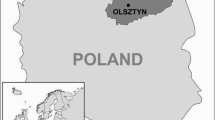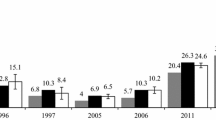Abstract
Ixodes ricinus is considered as the main vector of Lyme Borreliosis in France. The aim of our investigations was to obtain a comprehensive view of the spatial risk linked to the distribution of the species in our country. Previous studies [1] have provided strong evidence that the species populations are widely distributed, so the objective of the present work was to ascertain the bacteriological infection of the tick by the agent of the zoonosis (Borrelia burgdorferi, sensu lato), over the French territory, whatever the ecological conditions may be. For this purpose, we kept the same framework as that used in our acarological investigation, a phytoecological zoning of the territory into 54 geographically separate and ecologically distinct units distributed into three climatic zones. Batches of ticks, picked up in these different phytoecological units (only two thirds of which were sampled), were submitted for bacteriological investigation. A total of 4,673 ticks were examined, individually, for the presence of Borellia burgdorferi, by immunofluorescence. Percentages of infection according to the various stages of Ixodes ricinus free stages, collected by flagging, were as follows: 4.95% in 3,247 nymphs, 11.2% in 699 males, 12.5% in 727 females. Larvae were ignored. Practically all the tested units harboured the bacterium. The percentage of tick samples (25 ticks or more) absolutely free of Borrelia, wherever they came from, is very low (not exceeding 10 percent of the sampled forests). Our study confirms the assessment of a widespread distribution of the zoonosis in France which was, until now, exclusively based on an approximate distribution of limited human cases observed in the country.
Similar content being viewed by others
References
Gilot B, Guiguen C, Degeilh B, Doche B, Pichot J, Beaucournu JC. Phytoecological mapping of Ixodes ricinus as an approach of the distribution ofLyme borreliosis in France. In: Axford JS, Rees DHE (eds), Lyme borreliosis [Nato meeting]. New York: Plenum Press, 1994: 105–112.
Korenberg EI. Comparative ecology and epidemiology of Lyme disease and tick-borne encephalitis in the former Soviet Union. Parasitology Today 1994; 10: 157–160.
Marquez FJ, Constant MC. Infection d'Ixodes ricinus (L. 1758) etHaemaphysalis punctata (Canestrini et Fanzago, 1877) (Acarina, Ixodidae) parBorrelia burgdorferi dans le nord de la péninsule ibérique (Pays basque espagnol et Navarre). Bulletin de la Société Française de Parasitologie 1990; 8: 323–330.
Nuttal P, Randolph S, Carey D, Craine N, Livesley A, Gern L. The ecology of Lyme borreliosis in the UK: Lyme borreliosis. In: Axford JS, Rees DHE (eds), Lyme borreliosis [Nato meeting]. New York: Plenum Press, 1994: 125–131.
Bigaignon G, Martin P, Tomasi JP, Gonzalez M, Lozes E, Gillion P, Fain A. La maladie de Lyme en Belgique: Présence du spirochète Borrelia burgdorferi dans les tiques Ixodes ricinus récoltées dans la région mosane. Rev Med Liège 1989; 44: 489–493.
Wilske B, Steinhuber R, Bergmeister H, Fingerle V, Schierz G, Preac-Mursic V, Vanek E, Lorbeer B. Borreliose in Süddeutschland. Epidemiologische Daten zum Auftreten von Erkrankungsfällezn sowie zur Durchseuchung von Zecken (Ixodes ricinus) mit Borrelia burgdorferi. Dtsch Med Wochenschr 1987; 112: 1730–1736.
Mejlon HA, Jaenson TGT. Seasonal prevalence of Borrelia burgdorferi in Ixodes ricinus in different vegetation types in Sweden. Stand J Infect Dis 1993; 25: 449–456.
Kmety E, Rehacek J, Vyrostekova V. Investigations of ticks for the presence of Borrelia burgdorferi in Czechoslovakia. Zentralbl Bakteriol Hyg 1987; A 263: 468–478.
Ruzic-Sablijic E, Strle F, Cimperman J. The Ixodes ricinus tick as a vector of Borrelia burgdorferi in Slovenia. Eur J Epidemiol 1993; 9: 396–400.
Dupias G, Rey P. Documents pour un zonage des régions phytoécologiques. Toulouse: Centre d'Ecologie des Ressources renouvelables, CNRS, 1985, 40 pp.
Doche B, Gilot B, Degeilh B, Pichot J, Guiguen C. Utilisation de Findicateur végétal pour la cartographie d'une tique exophile À l'échelle de la France: exemple d' Ixodes ricinus (L. l'758), vecteur de la Borréliose de Lyme. Ann Parasitol Hum Comp 1993; 68: 188–195.
Degeilh B, Guiguen C, Gilot B, Doche B, Pichot J, Beaucournu JC. Répartition d' Ixodes ricinus (L. 1758) (Acarina:Ixodidae) dans les groupements forestiers du Massif Armoricain. Acarologia 1994; 35: 327–334.
Gilot B, Doche B, Degeilh B, Guiguen C, Pichot J. Bases acarologiques pour l'étude épidémiologique de la Borreliose de Lyme: les populations d' Ixodes ricinus Linné, 1758, du Sud-Ouest français. Acarologia 1995; 36: 117–132.
Walter DH, Lieth H. Klimatogramm. Welt Atlas. Jena: Fisher, 1960.
Gilot B. Bases biologiques, écologiques et cartographiques pour l'étude des maladies transmises par les tiques (Ixodidae et Argasidae) dans les Alpes françaises et leur avant-pays [Thesis Doctorat-ès-Sciences]. Grenoble, France: Universite de Grenoble, 1985, 535 pp.
Barbour AG. Isolation and cultivation of Lyme disease spirochetes. Yale J Biol Med 1984; 57: 521–525.
Doby JM, Chevrier S, Couatarmanach A, Imber-Hameurt C. Infection de Ixodes ricinus (Acarina:Ixodidae) par Borrelia burgdorferi, agent des spirochétoses à tique (maladie de Lyme et autres formes cliniques) dans l'Ouest de la France, II: Résultats détaillés et commentaires. Bulletin de la Société Française de Parasitologie 1989; 7: 227–289.
Gray JS. The development and seasonal activity of the tick Ixodes ricinus a vector of Lyme borreliosis. Rev Med Vet Entomol 199179: 323–333.
Dournon E, Assous M, Fourcade C. La maladie de Lyme en France (à propos de 272 cas). Bulletin épidémiologique hebdomadaire 1987; 15: 57–58.
Doby JM, Lemble C, Bigaignon G, Kremer M, Rolland C, Lambert MC. Borrelia burgdorferi, agent des spirochétoses à tiques (Maladie de Lyme et autres formes cliniques) chez Ixodes ricinus (Acarina:Ixodidae) en Alsace. Recherche chez 2.223 tiques. Bulletin de la Société Française de Parasitologie 1990; 8: 339–350.
Doby JM, Bigaignon G, Godfroid E, Bollen A, Murga-Gutierrez N. Fréquente de Borrelia burgdorferi, agent de la borréliose de Lyme chez les Stades nymphaux de Ixodes ricinus (Acarina:Ixodidae) dans divers massifs forestiers du Centre de la France. Bulletin de la Societe Française de Parasitologie 1993; 11: 163–168.
Macaigne F. Données épidémiologiques Sur la maladie de Lyme dans le département de la Gironde (France) [D.E.A. Biologie-Santé-option pathologie microbienne et virale]. Bordeaux, France: Universite de Bordeaux 11, 1991, 43 pp.
Kures L. Donnees epidemiologiques Sur la maladie de Lyme dans le departement de Meurthe-et-Moselle (France). [D.E.A.]. Paris, France: Universite Paris VI, 1992, 23 pp.
Perez-Eid C, Zhioua E, Deruaz D, Rodhain F. Epidemiological study of Lyme borreliosis in the area around Paris; Second European Symposium. A NATO Advanced Research Workshop, London, 19–20 Mai 1993.
Aeschlimann A, Chamot E, Gigon F, Jeanneret JP, Kesseler D, Walther C. B. burgdorferi in Switzerland. Zentralbl Bakteriol Hyg 1986; A 263: 450–458.
Gern L, Marval F de, Aeschlimann A. Comparative considerations on Lyme borreliosis and tick-borne encephalitis in Switzerland. In: Modern Acarology. Academic Press, 1991.
Haller X. Méningo-encéphalites à tiques, les cas alsaciens. Le point en 1991. Elements epidémiologiques des départements de l'Est [Thesis]. Strasbourg, France: Universite Louis Pasteur, 1992, 125 pp.
L'hostis M, Chauvin A, Valentin A, Marchand A, Gorenflot A. Large-scale survey of Babesia divergens bovine babesiosis in France. Veterinary Record 1995; 136: 36–38.
Humair PF, Turrian N, Aeschlimann A, Gem L. Borrelia burgdorferi in a focus of Lyme borreliosis: epizootiologic contribution of small mammals. Folia Parasitol 1993; 40: 65–70.
Jaenson TGT, Talleklint L. Incompetence of Roe Deer as reservoir of the Lyme borreliosis spirochete. J Med Entomol 1992; 29: 813–817.
Rouvinez E, Toutoungi LN, Gem L. Can the hedgehog, Erinaceus europaeus be considered as an amplifying host for Borrelia burgdorferi? Revue Suisse de Zoologie 1994; 101: 863.
Fayard A. Atlas des mammifères sauvages de France. Paris: Société Française pour l'Étude et la Protection des Mammifères 1984.
Matuschka FR, Heiler M, Eiffert H, Fischer P, Lotter H, Spielman A. Diversionary role of foofed game in the transmission of Lyme disease spirochetes. Am J Trop Med Hyg 1993; 48: 693–699.
Gray JS, Kahl O, Janetzki C, Stein J. Studies on the ecology of Lyme disease in a deer forest in country Galway, Ireland. J Med Entomol 1992; 29: 915–918.
Radda A, Burger I, Stanek G, Wewaklka G. Austrain hard ticks as vectors of Borrelia burgdorferi, an Overview. Zentralbl Bakteriol Hyg 1986; A 263: 79–82.
Zhioua E, Monin R, Gem L, Aeschlimann A. Infection of freeliving life-stages of Ixodes ricinus with Borrelia burgdorferi in Switzerland. Zentralbl Bakteriol Hyg 1988; 306:293.
Gilot B, Pichot J, Doche B. Tiques du Massif Central, I: Les populations de tiques parasites de carnivores et d'ongulés domestiques sur le rebord oriental du Massif. Acarologia 1989; 30: 8–24.
Author information
Authors and Affiliations
Rights and permissions
About this article
Cite this article
Gilot, B., Degeilh, B., Pichot, J. et al. Prevalence of Borrelia burgdorferi (sensu lato) in Ixodes ricinus (L.) populations in France, according to a phytoecological zoning of the territory. Eur J Epidemiol 12, 395–401 (1996). https://doi.org/10.1007/BF00145304
Accepted:
Issue Date:
DOI: https://doi.org/10.1007/BF00145304




